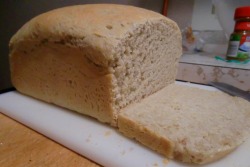The first leavened breads ever made were probably close to modern sourdoughs due to the simplicity of the ingredients involved: flour, water, salt, and sugar. Most scholars agree that Egypt was likely the birthplace of Sourdough bread around 1500 BCE. Like many of the great discoveries, sourdough was probably created on accident. It is easy to imagine an Egyptian baker walking in to find a pile of his flour wet and fermenting. My first thoughts probably wouldn’t have been “bread!” but hey, we’re glad his were. Through time, the process of creating a wild yeast culture for dough has been refined several times. There is no one correct way to make sourdough.
Over the years, the natural processes that go into creating sourdough have proven extremely reliable. In fact, when exploring the western United States sourdough was a staple food. During the California and Klondike Gold Rushes, yeast and baking soda just didn’t cut it as a leavening agents. Sourdough prevailed feeding the thousands of young men who made that trek. Perhaps the most famous Sourdough stems from these times. The Boudin family, from France, came to San Francisco and set up shop during the California Gold Rush. Their bread fed the miners who worked in the area. The sourdough they serve today is from the same mother dough they created in 1849.
Sourdough gets its name from its distinctly sour flavor. This taste comes from the lactic acid producing bacteria of the genus Lactobacillus. These bacteria are the same ones that make milk into buttermilk or yogurt. Each batch of sourdough is unique because it begins with a wild starter. That is, the bread is started with whatever microbes happened to be on the grain and in the air when the flour is mixed with water. This is why it is important to use unbleached flour. Bleaching the flour destroys many of the microbes that might be in flour. The use of local microbes is what distinguishes a San Francisco sourdough from say a Minneapolis sourdough. A small portion of the starter is saved each time a new loaf is made to preserve the distinct flavor for every new loaf.
Due to the uncontrollable variables associated with sourdough, it is difficult to get a good tasting starter. In general, it is necessary to control the acidity of the dough and cultivate a healthy yeast population. This involves keeping the starter cool after it begins and refreshing the dough by discarding half and feeding it more flour and water. The yeasts and bacteria feed on the sugars created by amylase enzymes that convert the starch from flour. Refreshing the dough takes out some of the acid produced from this process. Furthermore, while feeding the dough, it is important to incorporate some oxygen. The oxygen helps the yeast build cell membranes for new cells. If any of the above mentioned things does not happen, a couple things can go wrong. If you don’t feed the starter, the bacteria and yeast run out of food and die leaving you with a lifeless, flat bread. If the bacteria grow faster than the yeasts, it inhibits gas production resulting in a very flat, dense loaf of bread. If the yeast grows faster than the bacteria, you won’t get that distinctly sour flavor. If the starter is too acidic, the bacterial protein-digesting enzymes weaken the dough gluten which also produces a brick-like piece of dough.
The recipe I followed was from S. John Ross’s page, http://www.io.com/~sjohn/sour.htm. Admittedly, mine did not turn out very well. I couldn’t get it to rise enough and it lacked flavor. I’m told sourdough starter gets better over time so we’ll see how it goes next week. I just need to makes sure I tend well to my starter and keep it happy.
Over the years, the natural processes that go into creating sourdough have proven extremely reliable. In fact, when exploring the western United States sourdough was a staple food. During the California and Klondike Gold Rushes, yeast and baking soda just didn’t cut it as a leavening agents. Sourdough prevailed feeding the thousands of young men who made that trek. Perhaps the most famous Sourdough stems from these times. The Boudin family, from France, came to San Francisco and set up shop during the California Gold Rush. Their bread fed the miners who worked in the area. The sourdough they serve today is from the same mother dough they created in 1849.
Sourdough gets its name from its distinctly sour flavor. This taste comes from the lactic acid producing bacteria of the genus Lactobacillus. These bacteria are the same ones that make milk into buttermilk or yogurt. Each batch of sourdough is unique because it begins with a wild starter. That is, the bread is started with whatever microbes happened to be on the grain and in the air when the flour is mixed with water. This is why it is important to use unbleached flour. Bleaching the flour destroys many of the microbes that might be in flour. The use of local microbes is what distinguishes a San Francisco sourdough from say a Minneapolis sourdough. A small portion of the starter is saved each time a new loaf is made to preserve the distinct flavor for every new loaf.
Due to the uncontrollable variables associated with sourdough, it is difficult to get a good tasting starter. In general, it is necessary to control the acidity of the dough and cultivate a healthy yeast population. This involves keeping the starter cool after it begins and refreshing the dough by discarding half and feeding it more flour and water. The yeasts and bacteria feed on the sugars created by amylase enzymes that convert the starch from flour. Refreshing the dough takes out some of the acid produced from this process. Furthermore, while feeding the dough, it is important to incorporate some oxygen. The oxygen helps the yeast build cell membranes for new cells. If any of the above mentioned things does not happen, a couple things can go wrong. If you don’t feed the starter, the bacteria and yeast run out of food and die leaving you with a lifeless, flat bread. If the bacteria grow faster than the yeasts, it inhibits gas production resulting in a very flat, dense loaf of bread. If the yeast grows faster than the bacteria, you won’t get that distinctly sour flavor. If the starter is too acidic, the bacterial protein-digesting enzymes weaken the dough gluten which also produces a brick-like piece of dough.
The recipe I followed was from S. John Ross’s page, http://www.io.com/~sjohn/sour.htm. Admittedly, mine did not turn out very well. I couldn’t get it to rise enough and it lacked flavor. I’m told sourdough starter gets better over time so we’ll see how it goes next week. I just need to makes sure I tend well to my starter and keep it happy.



